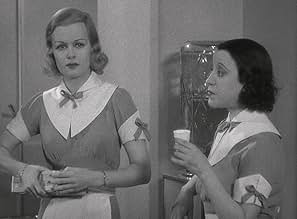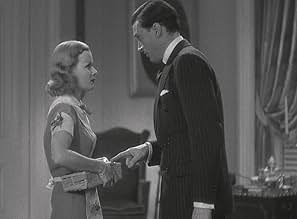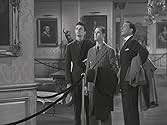AVALIAÇÃO DA IMDb
6,5/10
1,2 mil
SUA AVALIAÇÃO
Adicionar um enredo no seu idiomaSassy manicurist Eve Fallon is recruited as an even more brassy reporter and she helps police detective boyfriend Danny Barr break a jewel theft ring and solve the murder of a baby.Sassy manicurist Eve Fallon is recruited as an even more brassy reporter and she helps police detective boyfriend Danny Barr break a jewel theft ring and solve the murder of a baby.Sassy manicurist Eve Fallon is recruited as an even more brassy reporter and she helps police detective boyfriend Danny Barr break a jewel theft ring and solve the murder of a baby.
- Direção
- Roteiristas
- Artistas
- Prêmios
- 2 vitórias no total
Henry Brandon
- Don Butler
- (as Henry Kleinbach)
Fred Anderson
- Elevator Operator
- (não creditado)
William Arnold
- Customer
- (não creditado)
Mary Bovard
- Manicurist
- (não creditado)
Don Brodie
- Customer
- (não creditado)
Ralph Brooks
- Man Exiting Elevator
- (não creditado)
- Direção
- Roteiristas
- Elenco e equipe completos
- Produção, bilheteria e muito mais no IMDbPro
Avaliações em destaque
This little movie is more than forgotten. It is so mundane that no one has decided they can make a nickle from it, despite having some of the very same features and creative crew as projects that are celebrated. Cary Grant is about the same here, as in, say, "Charade."
I have to admit, it is flat. It all can be laid at the feet of the writer, I suppose.
These comedies are delicate. I suppose they cannot be engineered, like so much in film can. Oh, the execution can of course, but if the writer doesn't froth intuitively, nothing can spin it in after the fact.
But then again, this was the 30's where experimentation was the rule. And I suppose you need several failures before you get a "His Girl Friday" (which this resembles) out of so many tries.
Ted's Evaluation -- 1 of 3: You can find something better to do with this part of your life.
I have to admit, it is flat. It all can be laid at the feet of the writer, I suppose.
These comedies are delicate. I suppose they cannot be engineered, like so much in film can. Oh, the execution can of course, but if the writer doesn't froth intuitively, nothing can spin it in after the fact.
But then again, this was the 30's where experimentation was the rule. And I suppose you need several failures before you get a "His Girl Friday" (which this resembles) out of so many tries.
Ted's Evaluation -- 1 of 3: You can find something better to do with this part of your life.
Yes, it's true. The actor who in a few years would become the ultimate symbol of film sophistication and elegance has the role of a policeman in this fairly routine comedy-drama. But no matter. Grant has enough charm and grace to make even this kind of part his own. How did he do it? Grant just stands out and is so likable while a lesser actor would just walk through this rather thankless assignment.
Joan Bennett played the kind of sassy brassy part that was often taken on by the likes of Ginger Rogers or Joan Blondell. Did anyone else catch her throwaway line that mirrored Mae West's famous "come up and see me sometime?" Many folks don't remember that Bennett was a blond BEFORE she became better known to later movie audiences as a brunette. Does anyone know of any other famous actress who made such a transition? Not me.
The rest of the cast did serviceable work in the film. Douglas Fowley, who played a humorous bit as one of the crooks, is far better known to most film audiences as the harried movie director in "Singing in the Rain," who had to deal with the chaotic and riotous problems of bringing sound to what were formerly silent movies.
But this film belongs to its male lead. You can almost see in watching the movies he made at this time just how he developed the layers of "business" that came together to produce the screen personality we all know as Cary Grant. He may have been paying his dues by taking on this fairly routine role. In the long run----we are all the better for it. Cary Grant was one of the greatest screen actors of all time----maybe the greatest.
Joan Bennett played the kind of sassy brassy part that was often taken on by the likes of Ginger Rogers or Joan Blondell. Did anyone else catch her throwaway line that mirrored Mae West's famous "come up and see me sometime?" Many folks don't remember that Bennett was a blond BEFORE she became better known to later movie audiences as a brunette. Does anyone know of any other famous actress who made such a transition? Not me.
The rest of the cast did serviceable work in the film. Douglas Fowley, who played a humorous bit as one of the crooks, is far better known to most film audiences as the harried movie director in "Singing in the Rain," who had to deal with the chaotic and riotous problems of bringing sound to what were formerly silent movies.
But this film belongs to its male lead. You can almost see in watching the movies he made at this time just how he developed the layers of "business" that came together to produce the screen personality we all know as Cary Grant. He may have been paying his dues by taking on this fairly routine role. In the long run----we are all the better for it. Cary Grant was one of the greatest screen actors of all time----maybe the greatest.
An adequate comedy/mystery, one that is serviceable while playing but will scarcely be remembered long after it concludes. In all fairness, the jumbled screenplay by Bert Hanlon and director Raoul Walsh has a reasonable degree of intriguing ideas spread throughout the picture's scant runtime, but the various story threads never gel into a completely coherent picture and the film is further hindered by some woefully leaden dialogue among it's lead characters. The film is still wholly watchable, and even enjoyable during certain stretches due to it's lead performers. The chemistry between Cary Grant and Joan Bennett (as a bickering couple thrown into a case involving stolen jewels and murder) is breezy and natural, and the duo significantly better the film with their thoroughly winning performances.
And in that of Raoul Walsh, as well. The early scenes, which try really hard to be cute, show no influence of Walsh. When it gets more into the career of policeman Grant, we see some fast-paced action and it makes sense as a Walsh project. Sort of.
Grant was young and hadn't become a major star yet. He looks great and does a creditable job. His female co-star is Joan Bennett. Now there was an interesting actress: She worked with all the great foreign directors when they came to Hollywood. She made several movies for Fritz Lang. She worked for Max Ophuls. She worked for Jean Renoir.
Here she is a blonde, like sister Constance. She's fine.
Walter Pidgeon looks young too. He is cast in the sort of role Robert Montgomery or Warren William got more frequently: He's a charming crook.
When the movie begins, Bennett is a manicurist. Then, suspiciously quickly, she's an ace newspaper reporter. Was this little film assembled from various attempts or is the plot just a little unconvincing? There are many wonderful reaction shots that move quickly from close-up of one bit player or extra to close-up of another. I think the most famous use of this sort of extreme close-up is that of the chatty woman in "Brief Encounter." But the ones here are great. Indeed, they elevate what is essentially a trivial movie up a notch or two.
Grant was young and hadn't become a major star yet. He looks great and does a creditable job. His female co-star is Joan Bennett. Now there was an interesting actress: She worked with all the great foreign directors when they came to Hollywood. She made several movies for Fritz Lang. She worked for Max Ophuls. She worked for Jean Renoir.
Here she is a blonde, like sister Constance. She's fine.
Walter Pidgeon looks young too. He is cast in the sort of role Robert Montgomery or Warren William got more frequently: He's a charming crook.
When the movie begins, Bennett is a manicurist. Then, suspiciously quickly, she's an ace newspaper reporter. Was this little film assembled from various attempts or is the plot just a little unconvincing? There are many wonderful reaction shots that move quickly from close-up of one bit player or extra to close-up of another. I think the most famous use of this sort of extreme close-up is that of the chatty woman in "Brief Encounter." But the ones here are great. Indeed, they elevate what is essentially a trivial movie up a notch or two.
Big Brown Eyes would have been a big fat bomb if Cary Grant hadn't carried the movie. Even in such an early picture (1936) his debonair, yet cheeky gentleman style is evident. Playing a detective seemed odd, yet no matter what role he is cast in, he makes it his own. His romantic interest, Joan Bennett, seemed a tad too hard around the edges to play his girlfriend, but she did manage some decent repertoire with Grant, especially when the packing scene in Grant's apartment. Overall, the picture is uneven. It can't decide if it is a serious crime/drama or a light comedy. There is a scene where a stray bullet kills a baby (intimated) and there is nothing funny about that. Another scene a man is shot while arranging roses. It's incongruent action like these scenes that makes this movie just short of unwatchable. I have yet to see a Cary Grant movie that I didn't like, and this one seems a practice for his all out great flick His Gal Friday. Big Brown Eyes is watchable, only because of Cary Grant.
Você sabia?
- CuriosidadesAt 20 minutes, Eve Fallon (Joan Bennett) says to Danny Barr (Cary Grant), with a flirtatious wink, "if you happen to be around my way, come up and see me some time". This appears to refer to a famous, almost identical line said by Mae West to Cary Grant in "She Done Him Wrong" (1933), a playful in-joke that would have been obvious to contemporary audiences.
- Citações
Richard Morey: Cortig, if you bought a gift for a girl and she refused to accept it, what would you do?
Russ Cortig: [with a slow smile] I'd give it to my wife.
- ConexõesFeatured in The True Adventures of Raoul Walsh (2014)
Principais escolhas
Faça login para avaliar e ver a lista de recomendações personalizadas
- How long is Big Brown Eyes?Fornecido pela Alexa
Detalhes
- Tempo de duração1 hora 17 minutos
- Cor
- Proporção
- 1.37 : 1
Contribua para esta página
Sugerir uma alteração ou adicionar conteúdo ausente

Principal brecha
By what name was Olhos Castanhos (1936) officially released in India in English?
Responda
































